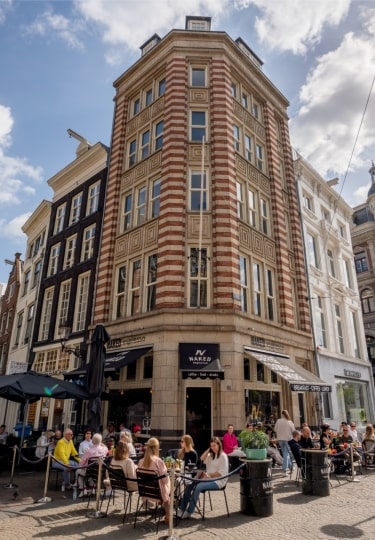If you find yourself wondering what to eat in Amsterdam, fear not. These days, the vibrant Dutch capital is something of a culinary hotspot.
You’ll find everything from Michelin-starred tasting menus to unpretentious homestyle cooking here. Because this is a highly cosmopolitan city, food in Amsterdam these days is hardly relegated to traditional Dutch cuisine.
The country is also renowned for its bakeries, which whip up buttery marvels that will satisfy any sweet tooth.
Here are just a few of the specialties to try on your next visit to Amsterdam.
Stroopwafels
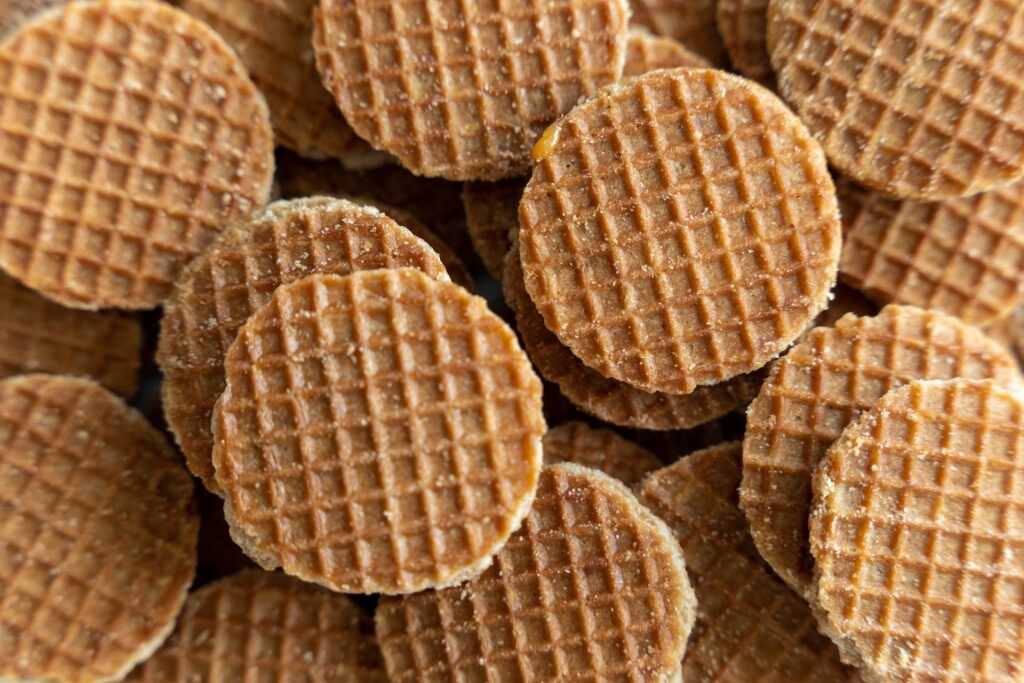
Stroopwafels
It’s hard to imagine a more perfect accompaniment to coffee than a stroopwafel. The name, which translates to “syrup waffle,” refers to the saccharine filling in the middle. The “waffles” in question are really cinnamon-scented, buttery cookies.
When placed over a steaming mug, the whole confection warms and softens, releasing the aromas of the spices. The pro move here is only to fully soften one side of the cookie, giving you contrasting crisp-chewy textures.
No one quite knows who invented the stroopwafel, although it is believed to have originated in Gouda around the late 18th or early 19th century. A common theory is that thrifty bakers threw together other scraps of dough and bound them with syrup. These days, stroopwafels can be found all over the world.
Nevertheless, the mass-produced specimens pale in comparison to the real deal. Head to Rudi’s Original Stroopwafels, an outpost of a bakery in Gouda, in the Albert Cuyp Market. Or pay a visit to Hans Egstorf Bakery, the oldest bakery in Amsterdam. The place has been in business since 1898 in a gorgeous art nouveau building.
Herring
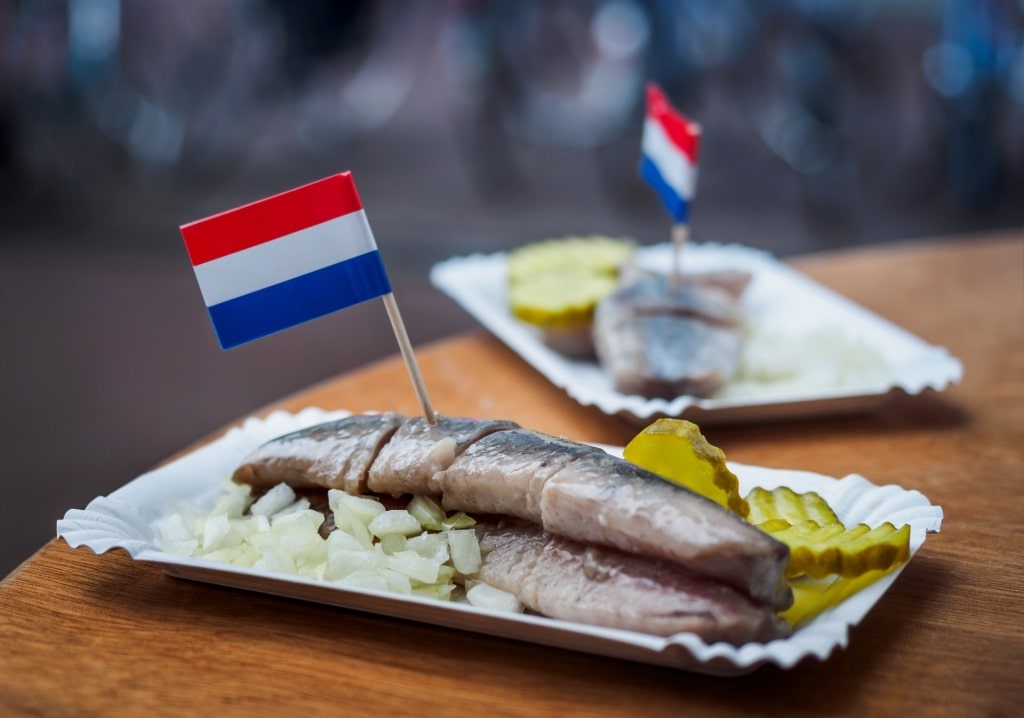
Herring
The Nordsee, or North Sea, has long been a focal point in Dutch life. One of the greatest culinary gifts of these frigid waters is the annual herring catch. During the 1600s, herring were such a plentiful and profitable catch that they helped fund the country’s large naval fleet.
Today, these small, slightly oily fish are a seasonal delicacy—not to mention a sustainable seafood choice high in beneficial omega-3 fatty acids. They can be served grilled, fried, pickled, or smoked.
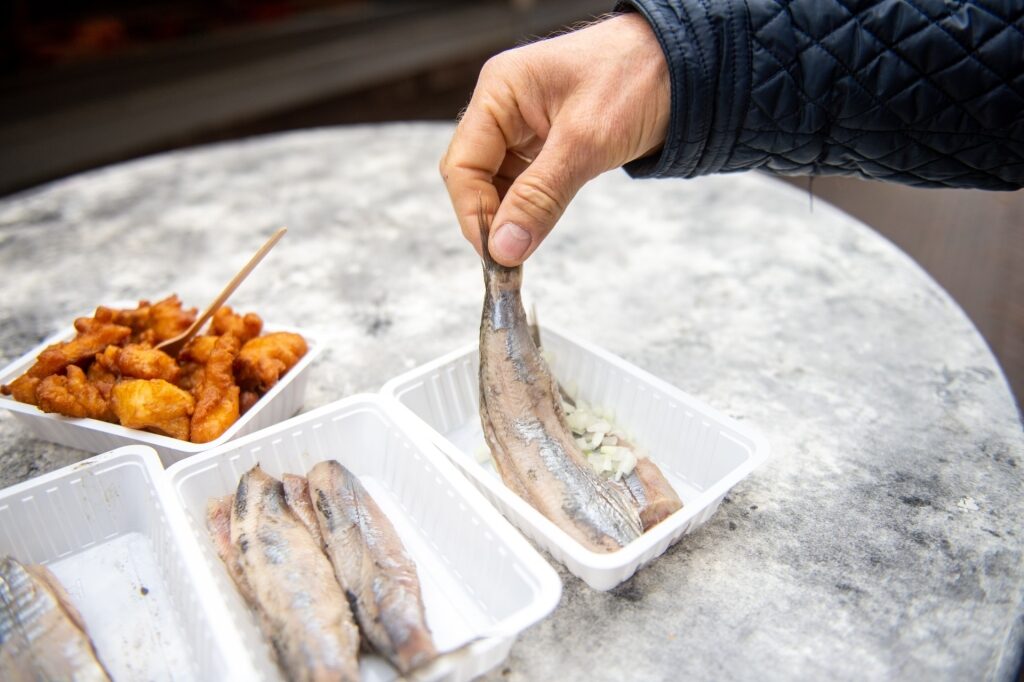
Herring
But if you’d like to partake of a distinctly Dutch tradition, try eating your herring raw. For the squeamish, don’t worry—this fish is perfectly safe. Herring is traditionally lightly salted and flash-frozen for a couple of days to kill off any potential parasites. It may also be “soused,” or soaked in a vinegar solution with seasonings.
Either way, tradition dictates that once the vertebrae is removed, you grab the whole fish by the tail and put it down the hatch. Raw onions are frequently served as an accompaniment.
Bitterballen
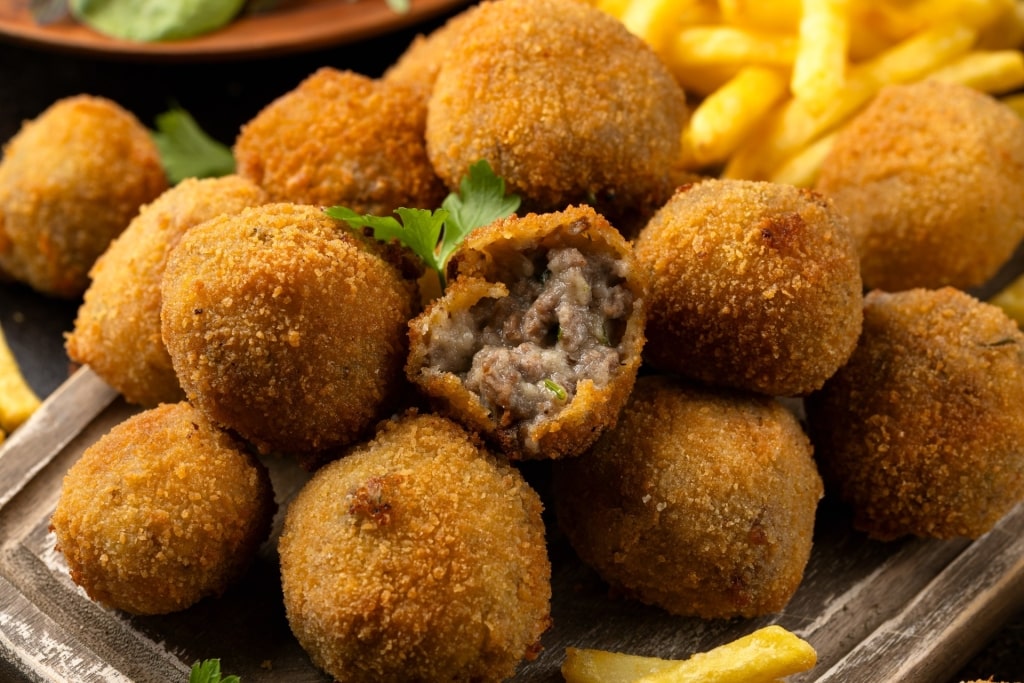
Bitterballen
The quintessential Dutch drinking snack, bitterballen are small fried meatballs found all over this foodie city. These nuggets are traditionally made by binding veal or beef with a thick roux, along with nutmeg, parsley, and other seasonings.
They’re then breaded, deep-fried, and served with a toothpick. Bitterballen are peak comfort food, often accompanied by a simple mustard dipping sauce.
Poffertjes
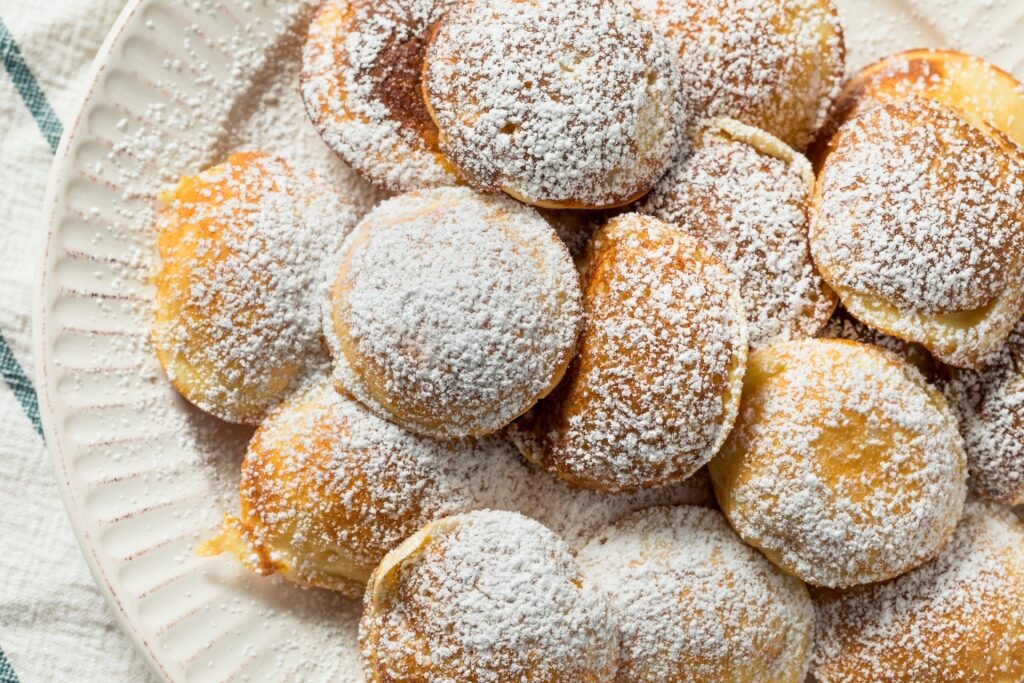
Poffertjes
If a silver dollar pancake and a doughnut hole had a baby, it might look a lot like poffertjes. These bite-sized treats are made in the generously buttered grooves of a special iron pan or griddle. They’re traditionally made with yeast, which makes the batter puff up dramatically into a small orb.
Traditionally, poffertjes are either showered in a blizzard of powdered sugar or drenched in stroop, the molasses-like Dutch syrup made from sugar beets. They’re a common site at street festivals, although a number of restaurants in Amsterdam serve them all year long.
Read: Best Things to Do in Jordaan, Amsterdam
Patatje Oorlog
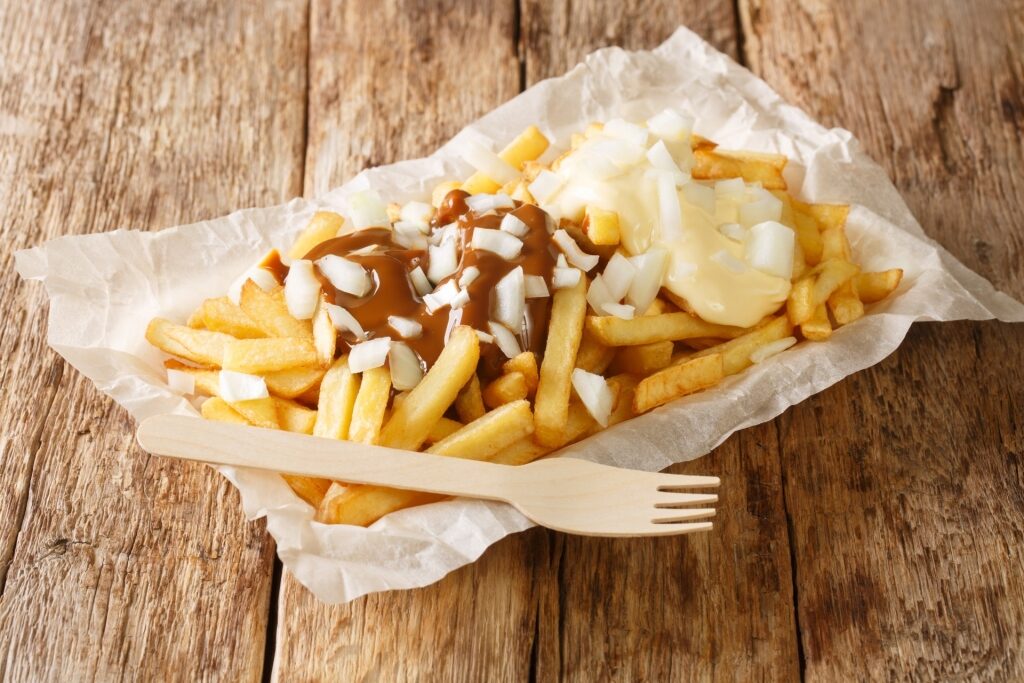
Patatje oorlog
Patatje oorlog, or “war fries,” are one of those over-the-top culinary concoctions that make the most sense after a beer or two. Much like in nearby Belgium, frietjes, or French fries are a national obsession in the Netherlands. Shops selling hand-cut, freshly fried potatoes by the paper cone-full keep locals in Amsterdam fueled at all hours of the day and night.
While you could always order your fries with mayonnaise, as is typical here, or ketchup, asking for a round of war fries really ups the ante. The cacophony of condiments comes with peanut satay sauce, mayonnaise, and raw onions all layered on top of one another. It’s every bit as gloriously messy to eat as it sounds.
Read: What Are the Netherlands Known For?
Kroket
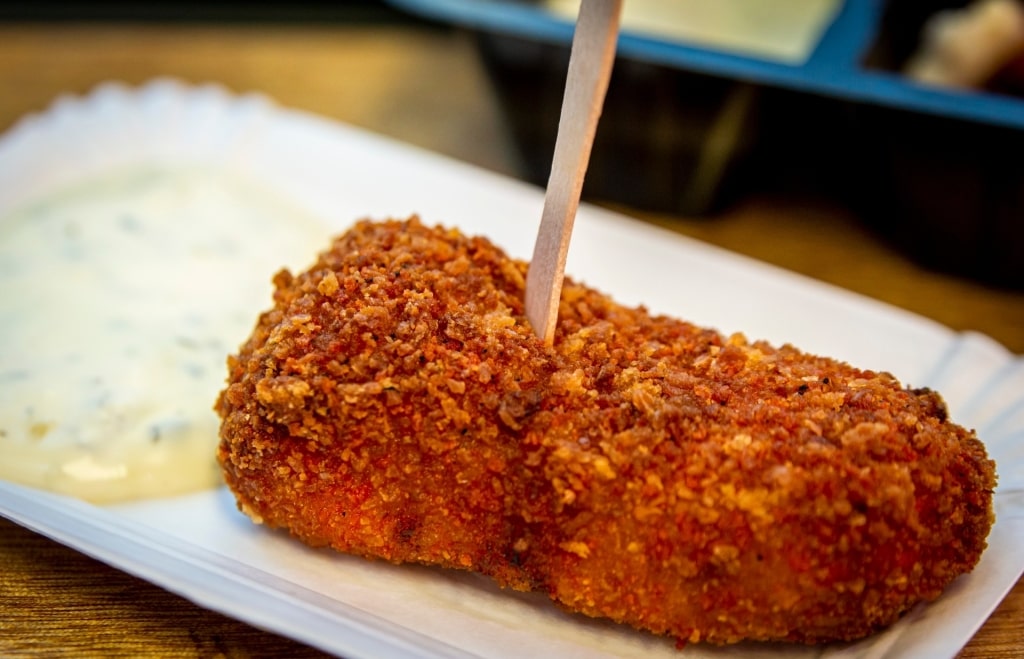
Kroket
Think of the kroket as the slightly more substantial cousin of the bitterbal. While the latter is barely even a mouthful, kroketten are roughly a two-bite oblong shape. These croquettes are also bound with either a meat stock thickened with roux or a creamier bechamel. Kroketten are traditionally made with beef, veal, or pork, but just about any kind of protein may be used.
Nowadays, vegetarian or vegan versions are relatively easy to find along with their meatier counterparts. Interestingly, kroketten are one of the grab-and-go snacks often found in Amsterdam’s vending machines. The Dutch capital is one of the few places where you can get hot food 24/7 simply with the press of a few buttons.
Rijsttafel
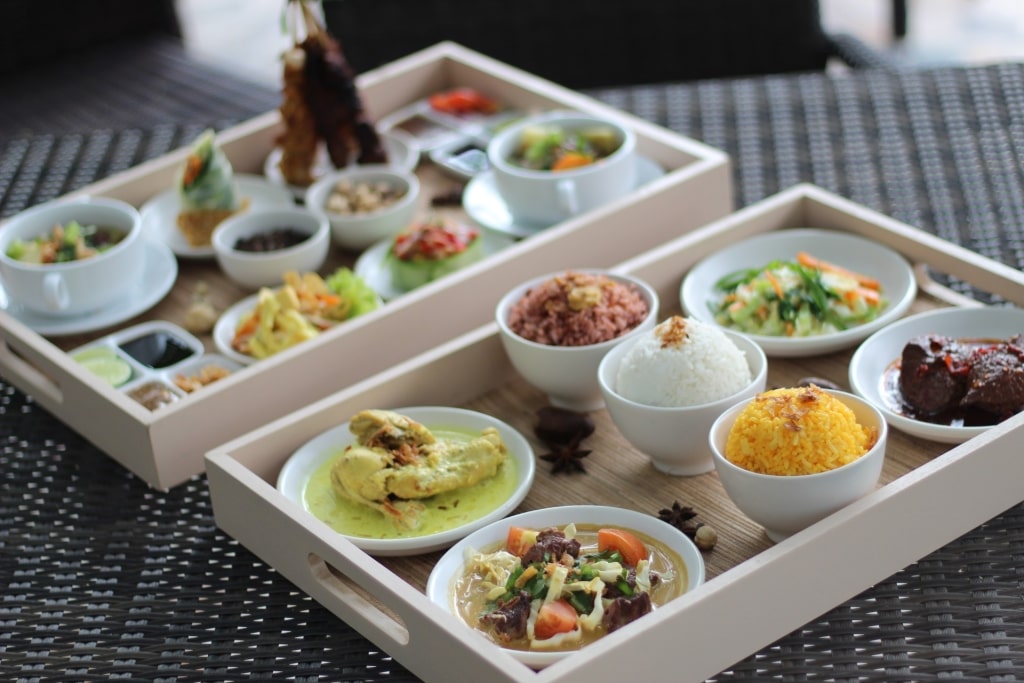
Rijsttafel
Arguably one of the best examples of food in Amsterdam isn’t really Dutch at all. The Dutch colonial period in Indonesia lasted from the early 17th century through the mid-20th century. In addition to large quantities of spices, one thing they brought back was a taste for the food.
Rijsttafel, or “rice table,” is essentially a composite of different regional dishes from the Indonesian archipelago. Yet this particular interpretation of dining would almost never be found in Indonesia itself. Instead, it’s wildly popular in the Netherlands and, to a lesser extent, South Africa, another former Dutch colony.
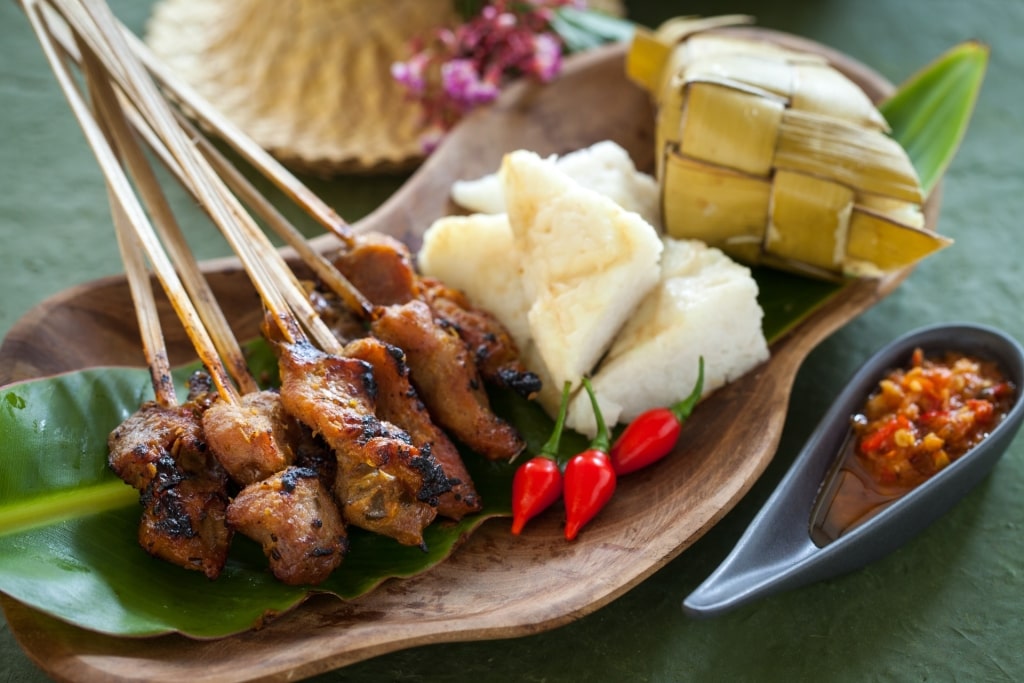
Rijsttafel
The basic concept most closely resembles nasi padang, a Sumatran dish in which rice is served with dozens of smaller dishes. But Javanese, Balinese, and other dishes are often incorporated into the overall presentation.
More than the specific dishes served, a rijsttafel is defined by the experience and style of presentation. Meals tend to be a set price, which includes a procession of appetizers, sambals, curries, satays, pickles, and other dishes.
Read: Amsterdam Travel Tips
Erwtensoep
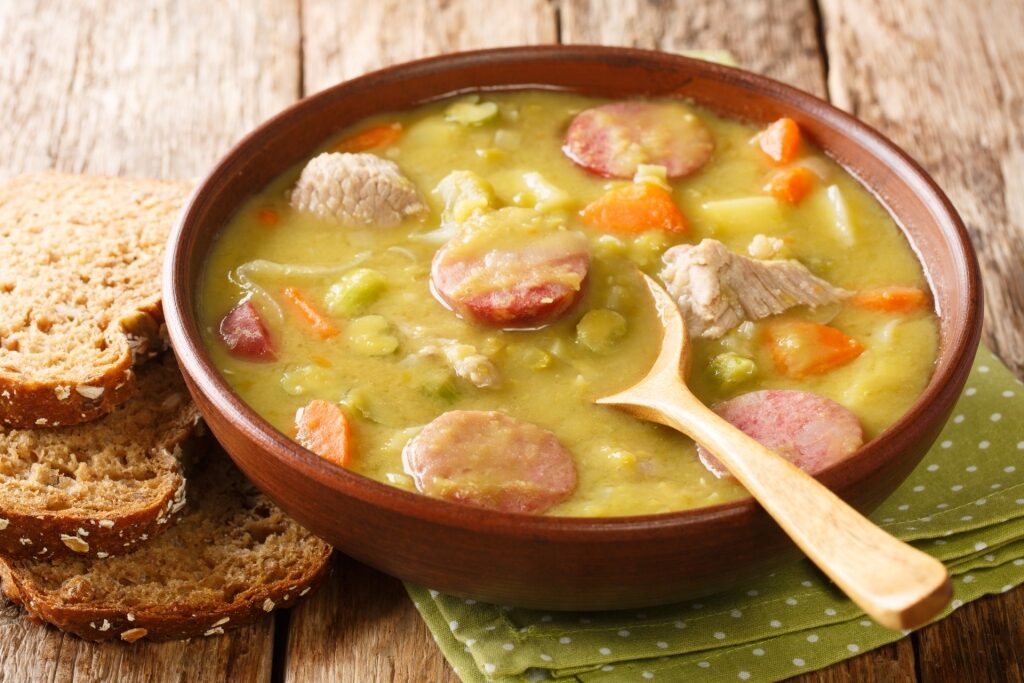
Erwtensoep
Winters in Amsterdam tend to be oppressively dark and rainy, which may explain why locals are so partial to hearty comfort foods. Right at the top of the list is erwtensoep, or split pea soup. The Dutch iteration of this humble staple is often on the thicker side, with a consistency veering into porridge territory. This dish is very much a complete meal in and of itself.
Part of the reason the soup has so much body is the starchy celeriac and potatoes which break down during cooking. The soup has a slightly smoky flavor courtesy of some sort of pork product. Rookworst, a common Dutch sausage, is a common addition, although other recipes throw in bacon bones, whole pork chops, or other cuts.
Hagelslag
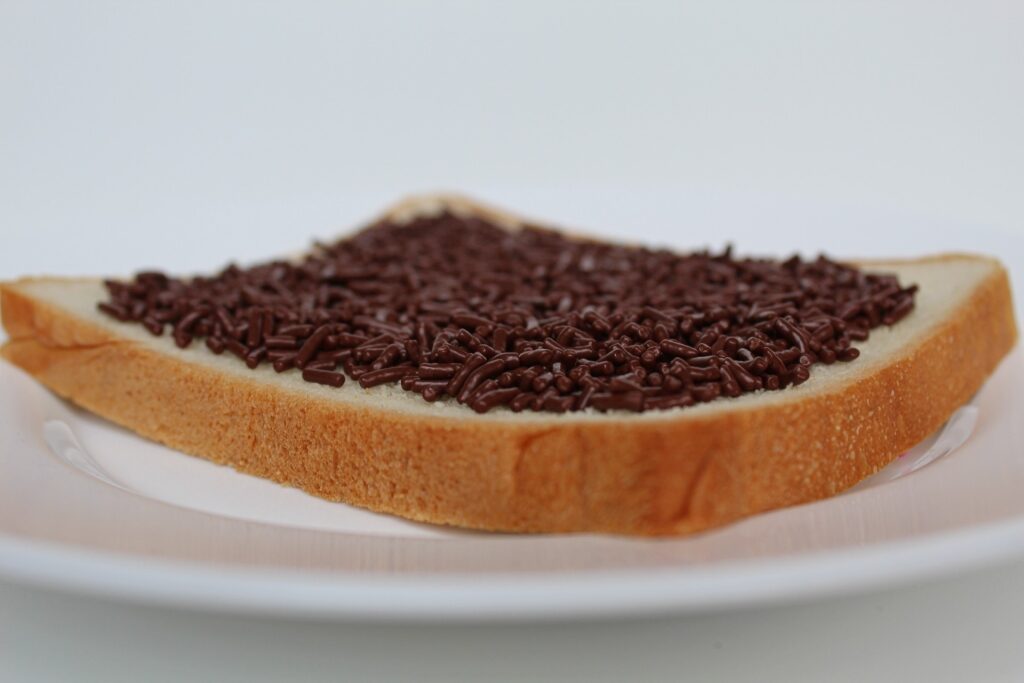
Hagelslag
To the uninitiated, the idea of eating chocolate sprinkles on buttered toast for breakfast might seem odd. For Dutch children, however, this sugary treat is the perfect start to the day. Supposedly, the dish got its start in 1936, when a five-year-old boy requested some sort of chocolate for his bread.
Curiously, although the word hagelslag is used for sprinkles, it literally translates to “hail storm.” Most likely the sprinkles—which are a bit heftier than their American ice cream sundae topping counterparts—were thought to resemble pieces of hail.
Oliebollen
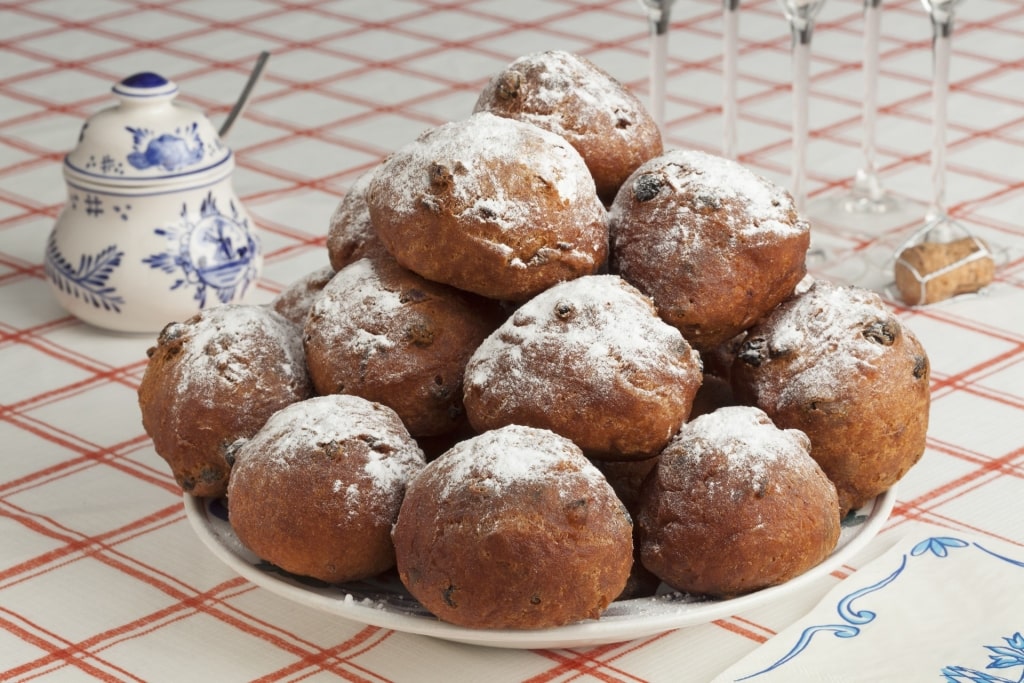
Oliebollen
These doughnuts are as much fun to say as they are to eat. The highly literal name translates as “oil balls,” although the best oliebollen are never greasy.
Instead, these yeasted fritters have a lighter-than-air texture reminiscent of beignets. They’re sometimes studded with raisins or filled with apples or berries, although they’re equally good plain. Either way, a generous dusting of powdered sugar before serving is essential.
Although no one quite knows the origins of these fritters, we do know that they’ve been around at least since the 1600s. Aelbert Cuyp, one of the Dutch Masters of the period, famously painted a woman whipping up a batch.
Oliebollen are a festive treat often found at carnivals and fairs throughout the Netherlands. They’re especially associated with Christmas and New Year’s, although they can be found all year long.
Kaassoufflé
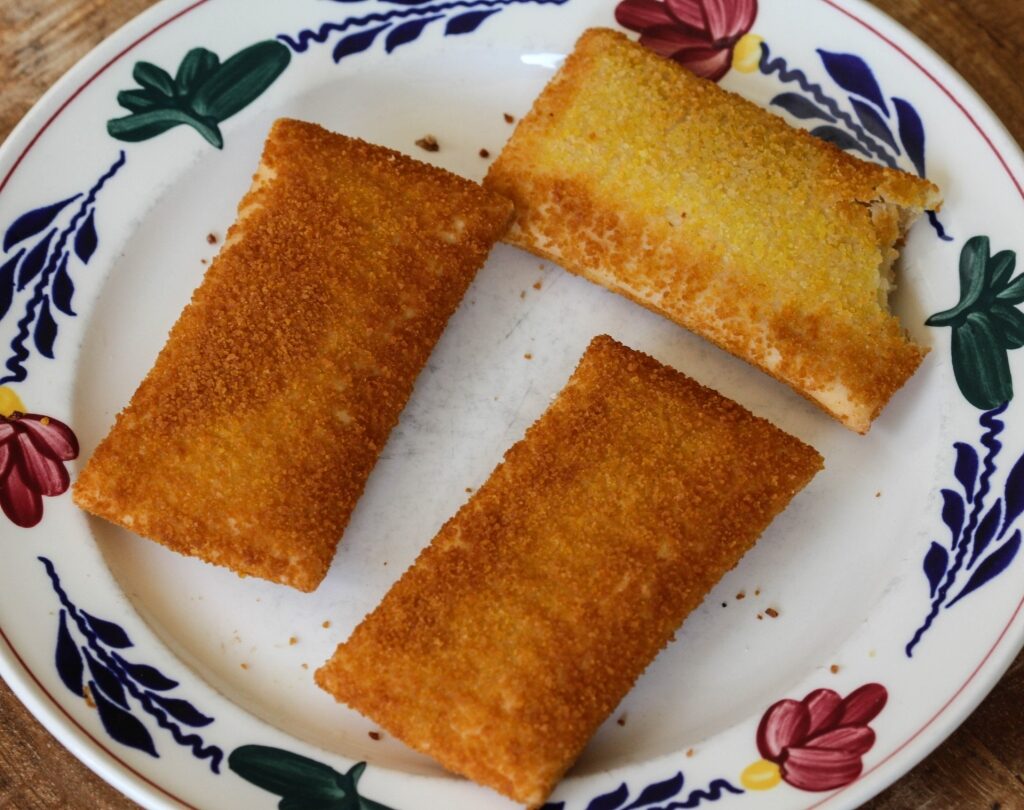
Kaassoufflé
The name may translate as “cheese souffle,” but you’d never confuse kaassoufflé with the voluminous French egg dish. Instead, this popular snack most likely has its roots in Indonesian street foods. It bears a resemblance to gorengan, which Dutch colonists would have encountered in the 1600s.
Essentially, a kaassoufflé consists of cheese encased in dough, which gets breaded and deep-fried. The result is a little like an extra melty, crunchy version of a cheese sandwich. It’s a common fast-food option, one often stocked in vending machines and convenience stores.
Appeltaart
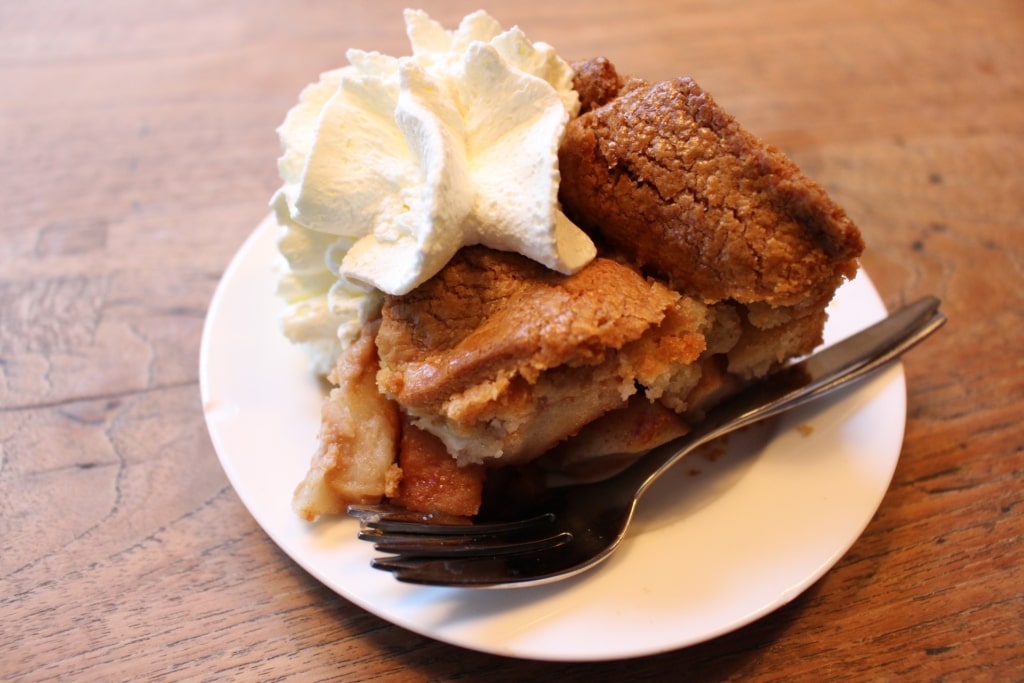
Appeltaart
Americans may love to declare apple pie as their own, but the truth is the Dutch are just as obsessed and arguably have a better claim. Roughly a century before the Pilgrims set foot on Plymouth Rock, Dutch bakers already had written down recipes for appeltaart.
It’s worth noting that appeltaart is decidedly different from its American cousin. For one, it’s often sky-high and packed with considerably more apples. For another, it’s really more of a cross between a cake and a tart. The crumbly, buttery dough that encases the sides of the apples is unlike a typical pastry crust. For that, try appelvlaai, a tart made with a shortcrust.
Nowadays, this dessert is ubiquitous in Amsterdam’s bakeries. It’s usually generously spiced with cinnamon and other warm spices. Plump raisins are a common addition. The Dutch tend to take their afternoon coffee break seriously. If you’re wondering what to eat in Amsterdam, there’s no more lovely accompaniment to a strong cuppa than a warm slice of this comforting sweet.
Kibbeling
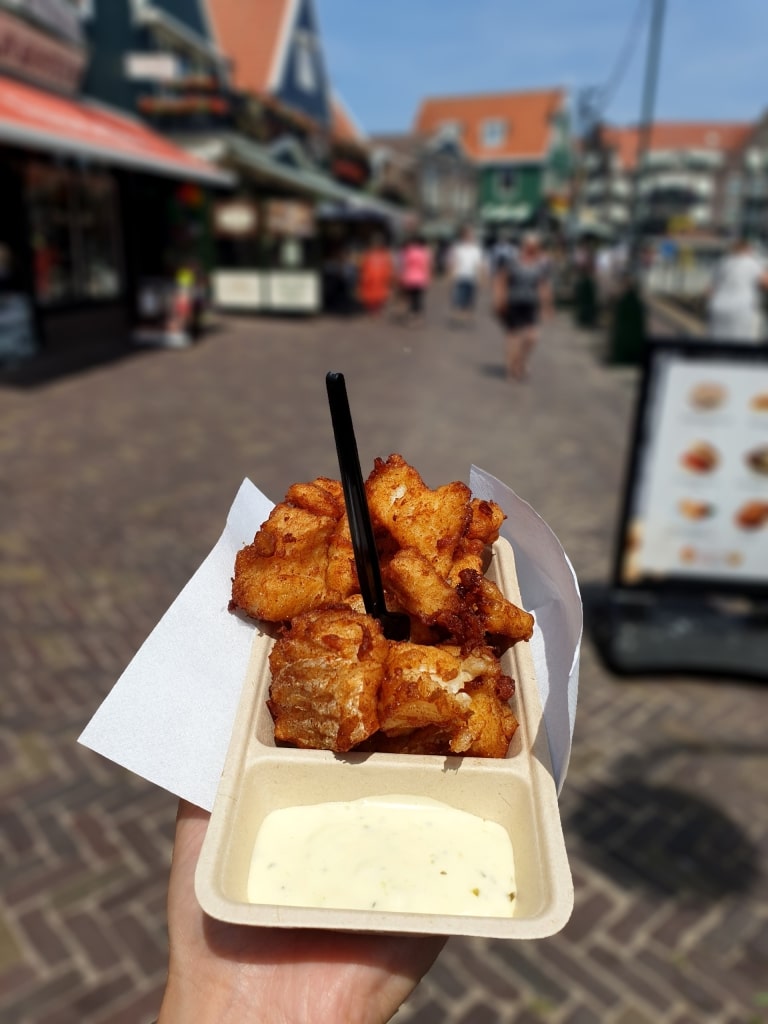
Kibbeling
Think of kibbeling as the Dutch answer to fish and chips. These nuggets of fried fish were historically a way to avoid wasting scraps of salt cod. These simple battered, crispy bites were so delicious that people started setting aside fresh fish to make them.
They’re served piping hot, usually with a garlicky mayo sauce for dipping.
Bossche Bol
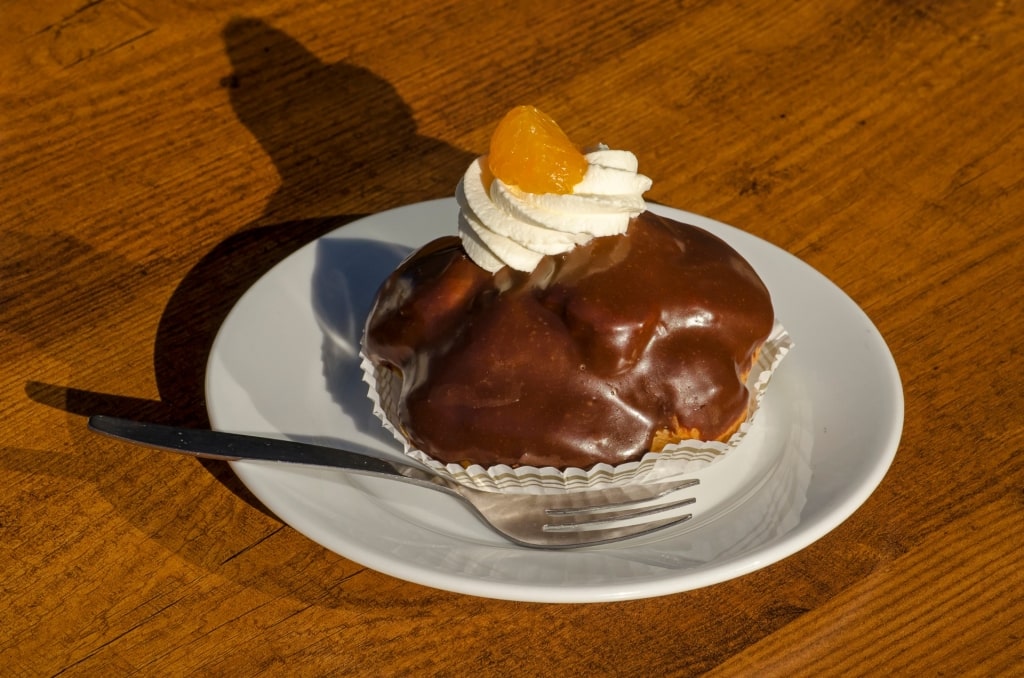
Bossche bol
In the city of Den Bosch, where this pastry originates, it’s simply known as a chocoladebol, or chocolate ball. The sweet first rose to national popularity in the 1920s.
Essentially, it consists of a ball of choux pastry covered in a rich chocolate glaze and filled with whipped cream. It’s a close cousin of the French profiterole, albeit with an airier, cloud-like filling. It’s ideal for snacking on with a strong cup of Dutch coffee.
Pannenkoeken
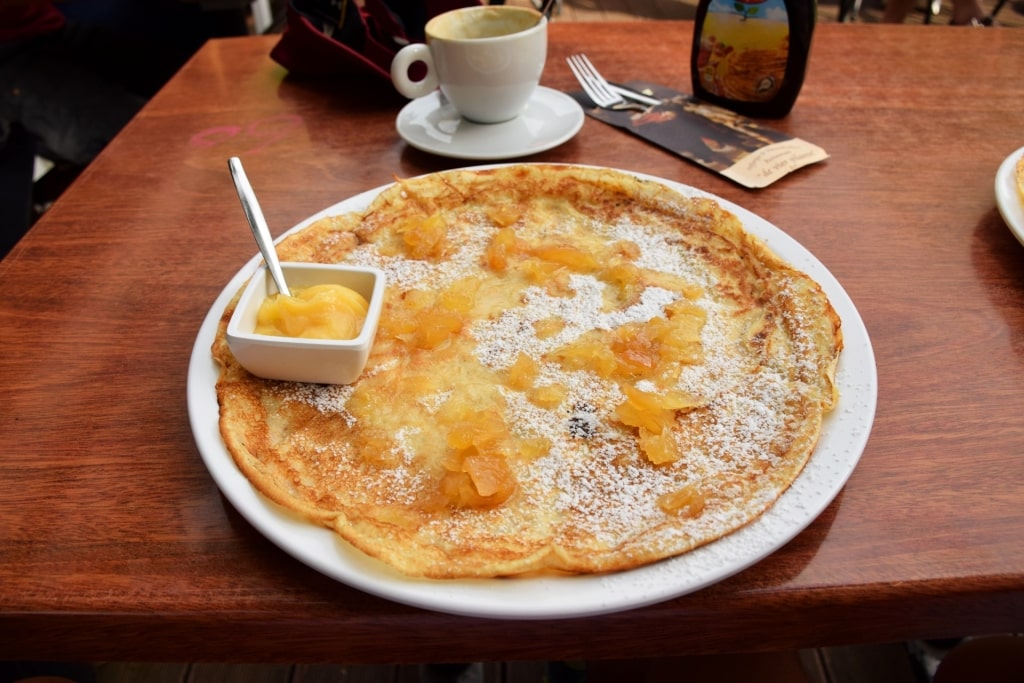
Pannenkoeken
Think of Dutch pannenkoeken as Parisian crepes on steroids. Slightly thicker and often as big as a Neopolitan pizza, these pancakes are very much a full meal. Most restaurants will offer both sweet and savory pannenkoeken.
In the former category, expect to find classic dessert combos like apples, cinnamon, and raisins or perhaps bananas and Nutella. In the latter, ham and cheese are common.
The beauty of pannenkoeken is that cooks can put just about anything on these enormous edible canvases. At Pancakehouse Upstairs, a closet-sized restaurant within the historic canal rings in Downtown Amsterdam, you can order your pannenkoeken with pulled beef or local strawberries and cream.
Speculaas

Speculaas
Around the festive season in Amsterdam, these thin gingerbread-spiced cookies are practically inescapable. Speculaas are made with intricate molds in the shape of windmills or other shapes. Often, they’re made with slivered, blanched almonds incorporated into the dough.
Although speculaas are, in essence, a Christmas cookie, they’re so famous that they can be found all year round in Amsterdam. Similar cookies can be found in Belgium, France, and Germany, although each region has their own distinct versions.
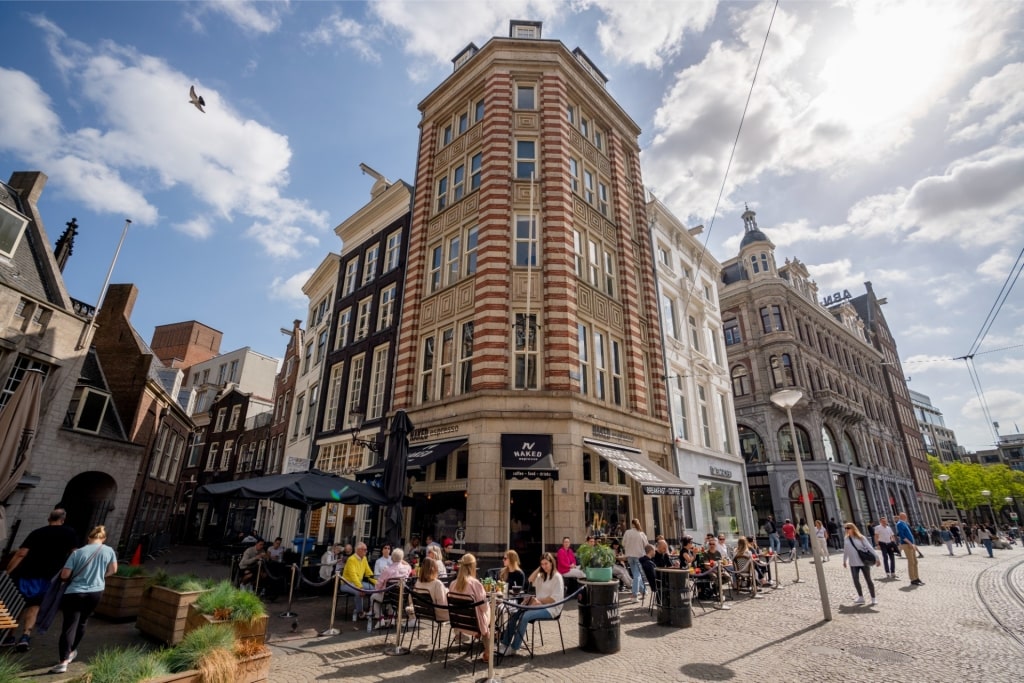
Restaurant in Amsterdam
Discover all sorts of delicious dishes in the Dutch capital for yourself. Browse Celebrity’s cruises to Amsterdam and book your next culinary adventure.
